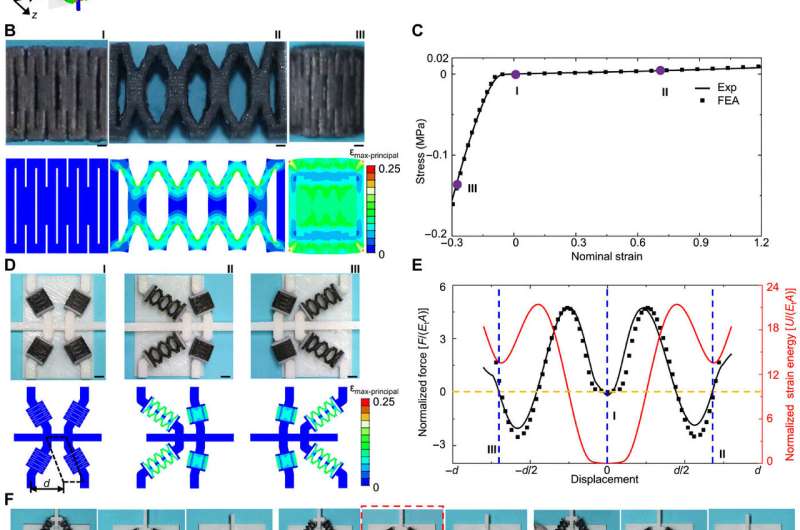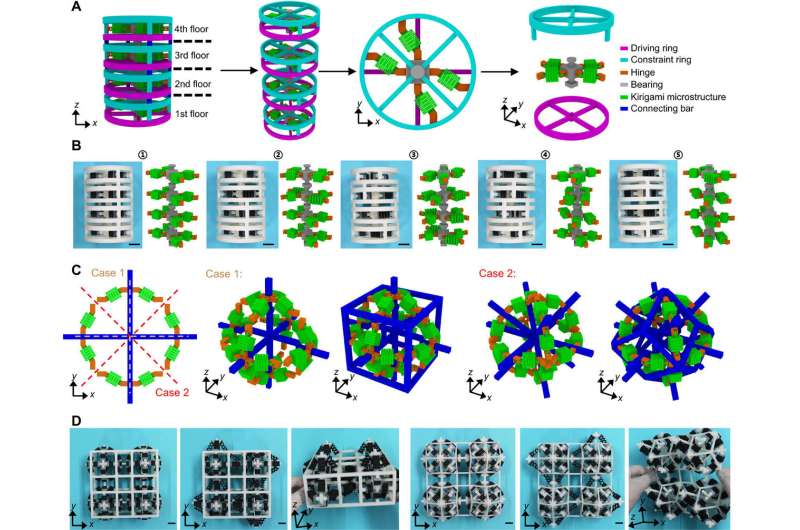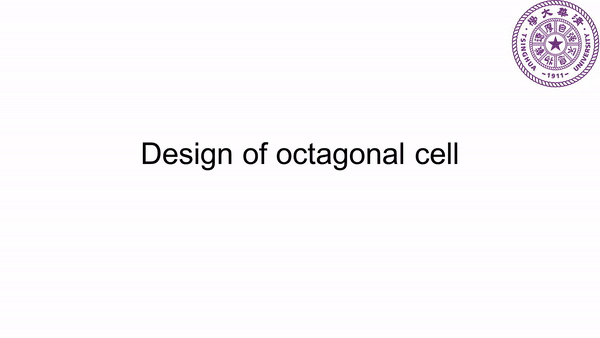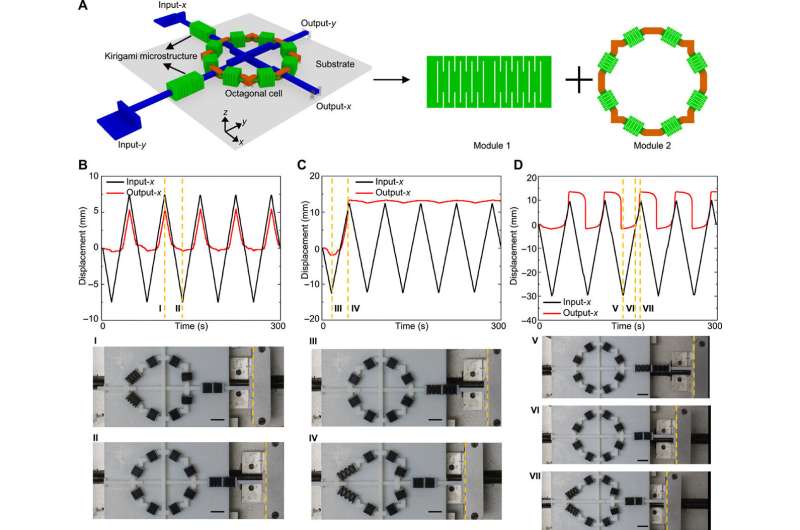March 12, 2021 feature
Hierarchical mechanical metamaterials offer multiple stable configurations

Multistable mechanical metamaterials are artificial materials whose microarchitecture offers more than two different stable configurations. Existing mechanical metamaterials rely on origami or kirigami-based designs with snap-through instability and microstructured soft mechanisms. Scalable structures that can be built from mechanical metamaterials with an extremely large number of programmable stable configurations remain elusive. In a new report now published on Science Advances, Hang Zhang and a research team in engineering, electronics, and advanced structure technology in Beijing China, used the elastic tensile/compressive asymmetry of kirigami microstructures to design a class of X-shaped tristable structures. The team used these constructs as building block elements to build hierarchical mechanical metamaterials with one-dimensional cylindrical geometries, 2D square lattices and 3D cubic or octahedral lattices with multidirectional multistability. The number of stable states increased with the cell number of mechanical metamaterials incorporated in the work, and the versatile multistability and structural diversity demonstrated applications within mechanical ternary logic operators with unusual functionalities.
Mechanical metamaterials
Mechanical metamaterials are a type of artificial materials consisting of periodic microstructures with architectures designed to offer mechanical properties that surpass conventional materials. Despite advances in the field, it remains challenging to design hierarchical metamaterials with diverse stable states and precisely tailored steady-state properties. In this work, Zhang et al. introduced a class of X-shaped kirigami microstructures as tristable building block elements starting from a bottom-up scheme to achieve hierarchical mechanical metamaterials, with an increased number of stable states. The elastic tensile-compressive asymmetry of kirigami microstructures and the independently controlled tristability of the hierarchical metamaterials allowed them to realize controlled low-frequency vibrations along different in-plane directions for desired functions, including noise suppression and nonlinear communication.
Multistable mechanical metamaterials with hierarchical constructions

The team conducted quantitative mechanical modeling of the X-shaped kirigami microstructures based on finite element analyses. The outcomes indicated a bending-dominated deformation mechanism under uniaxial stretching with a much lower tensile modulus and compressive modulus. The calculated strain energy indicated three minimum points to confirm the instability of the X-shaped building block structure. The scientists also presented multistable mechanical metamaterials with 1-D cylindrical geometries and 3D cubic or octahedral lattices. The design allowed two additional stable configurations based on clockwise or counterclockwise rotations as evidenced by the energy profile. The octagonal cell offered up to 320 stable configurations in theory, which was hitherto inaccessible. The extreme number of stable states provided a promising concept for information processing as shown with mechanical ternary logic gates and combined logic operators.

Relationship between mechanical properties and geometrical designs of kirigami microstructures and X-shaped building block structures
The scientists next sought to understand the microstructure-property relationship to assess the hierarchical design of the proposed multistable mechanical metamaterials. To accomplish this, they focused on the X-shaped building block structure and established the connection of its key geometric parameters to the resulting energy landscape. The team divided the geometric parameters into two categories one related to the kirigami microstructure and the other to the X-shaped composite. They then developed a finite-deformation theoretical model to predict the stress-strain curve of the kirigami microstructure, where the theoretical outcomes were in good agreement with the experiments. The team further increased the compressive modulus of the kirigami microstructures by replacing the connection region with hard polymers. The simulated microstructures that deformed under tension and compression were also in good agreement with the optical images.
![Microstructure-property relationship of the X-shaped building block structure. (A) Schematic illustration of the kirigami microstructure and the key design parameters. (B) Experimental and FEA results of the tensile stress-strain curves of the kirigami microstructure with a range of different normalized cut lengths (l¯1=l1/a and l¯2=l2/a). (C) Contour plot of the effective elastic modulus of the kirigami microstructure with respect to the normalized cut lengths (l¯1 and l¯2). (D) Experimental and FEA results of tensile and compressive stress-strain curves of the kirigami microstructure with homogeneous and composite designs. (E) Optical images and FEA results of the composite kirigami microstructure at different loading states [marked in (D)]. (F) Schematic illustration of the X-shaped building block structure. The key design parameters include the modulus ratio (η = Ec/Et) of the kirigami microstructure under compression to that under tension, the angle θ of the X-shaped structure, and the length ratio (L/L0). (G) Optical images and FEA results of the two stable configurations of X-shaped building block structures with θ = 25° and 40° (left and right) for fixed length ratio (L/L0 = 0.64). (H) Load-displacement curves of the homogeneous X-shaped building block structure with different angles (θ), for fixed modulus ratio (η = 101) and length ratio (L/L0 = 0.64). (I) Similar results in the case of different length ratios (L/L0) for fixed modulus ratio (η = 101) and angle (θ = 30°). (J) Load-displacement curves of the composite X-shaped building block structure with different angles (θ) for fixed modulus ratio (η = 240) and length ratio (L/L0 = 0.64). Scale bars, 1 mm (E) and 5 mm (G). Photo credits: Hang Zhang, Tsinghua University.Credit: Science Advances, doi: 10.1126/sciadv.abf1966 Hierarchical mechanical metamaterials](https://scx1.b-cdn.net/csz/news/800a/2021/2-hierarchical.jpg)
Mechanical ternary gates
The flexibility of the X-shaped tristable building block structure allowed applications of mechanical ternary logic function, which could not be achieved using bistable building blocks. For instance, with mechanical systems presented in earlier work, it was very challenging to combine many basic gates for complex logic operations. Comparatively, ternary logic operation could transmit a larger amount of information while using a reduced number of basic gates to complete the same operation and showed advantages in fuzzy logic and signal processing. The team further presented a mechanical ternary NOT gate composed of two modules including an analog-to-digital converter and a digital displacement processor. They realized the analog-to-digital converter using the X-shaped tristable building block structure and developed the digital displacement processor to reverse the direction of input displacement and conducted experimental demonstrations of the functionality of the fabricated NOT gate.
The ternary logic operation of AND and OR gates were more complicated compared to binary operators. The flexibility of the modular design facilitated complex logic operations based on the basic gates. The large number of stable states facilitated with multistable mechanical metamaterials allowed for complex ternary operations of multiple inputs. For instance, a logic operator based on a mechanical metamaterial served as an analog-to-digital converter integrated with a specially designed digital displacement processor to realize a complex target operation for four different inputs. Logic operators of this nature can allow parallel processing of inputs across different directions to obtain two independent outputs.

Controlling the amplitude of the low-frequency vibration
The scientists presented the designs of a bidirectional amplitude modulator developed with multistable mechanical metamaterials. They filtered low-frequency vibration from the experimental setup, where the negative input displacement was tremendously suppressed, while the positive input displacement transmitted with a relatively high fidelity. Such mechanical devices will be effective for integration in robots working in harsh environments such as high radiation and strong magnetic fields, where electronic devices would not function as effectively. The ability to modulate vibration can also be used for noise suppression and nonlinear communication.

Outlook
In this way, Hang Zhang and colleagues detailed the design, fabrication and characterization of a class of hierarchical mechanical metamaterials with an exponentially increased number of stable states. The team started with the programmable X-shaped tristable building block structure and progressed to design hierarchical mechanical metamaterials including 1-D cylindrical geometries, 2D square lattices and 3D cubic or octahedral lattices. These constructs showed capacity for torsional multistability or independently controlled multidirectional multistability. The outcomes shed light on the underlying relationship between the microstructural geometries and the resulting energy landscape. The team showed applications in mechanical ternary logic gates, including the three basic gates (AND, NOT, and OR gates) and their combined logic operations. The mechanical devices are promising for applications across soft robotics and actuators. The mechanical devices will be more advantageous than traditional electrical devices to save energy and for corrosion resistance in harsh environments.
More information: Zhang H. et al. Hierarchical mechanical metamaterials built with scalable tristable elements for ternary logic operation and amplitude modulation, Science Advances, DOI: 10.1126/sciadv.abf1966
Li X. and Gao H. Smaller and stronger. Nature Materials, doi.org/10.1038/nmat4591
Zhang X. et al. Theoretical strength and rubber-like behaviour in micro-sized pyrolytic carbon, Nature Nanotechnology, doi.org/10.1038/s41565-019-0486-y
Journal information: Science Advances , Nature Nanotechnology , Nature Materials
© 2021 Science X Network




















